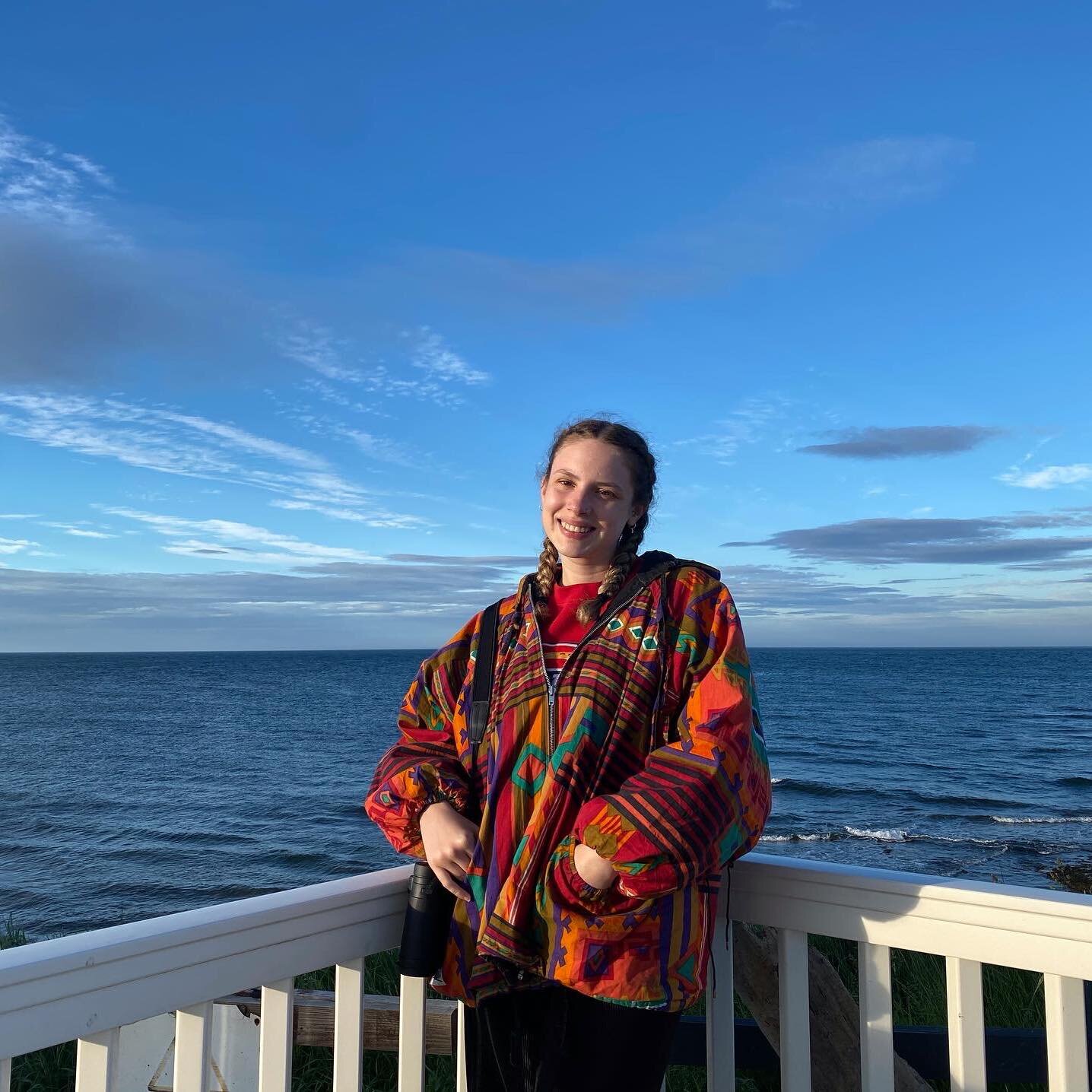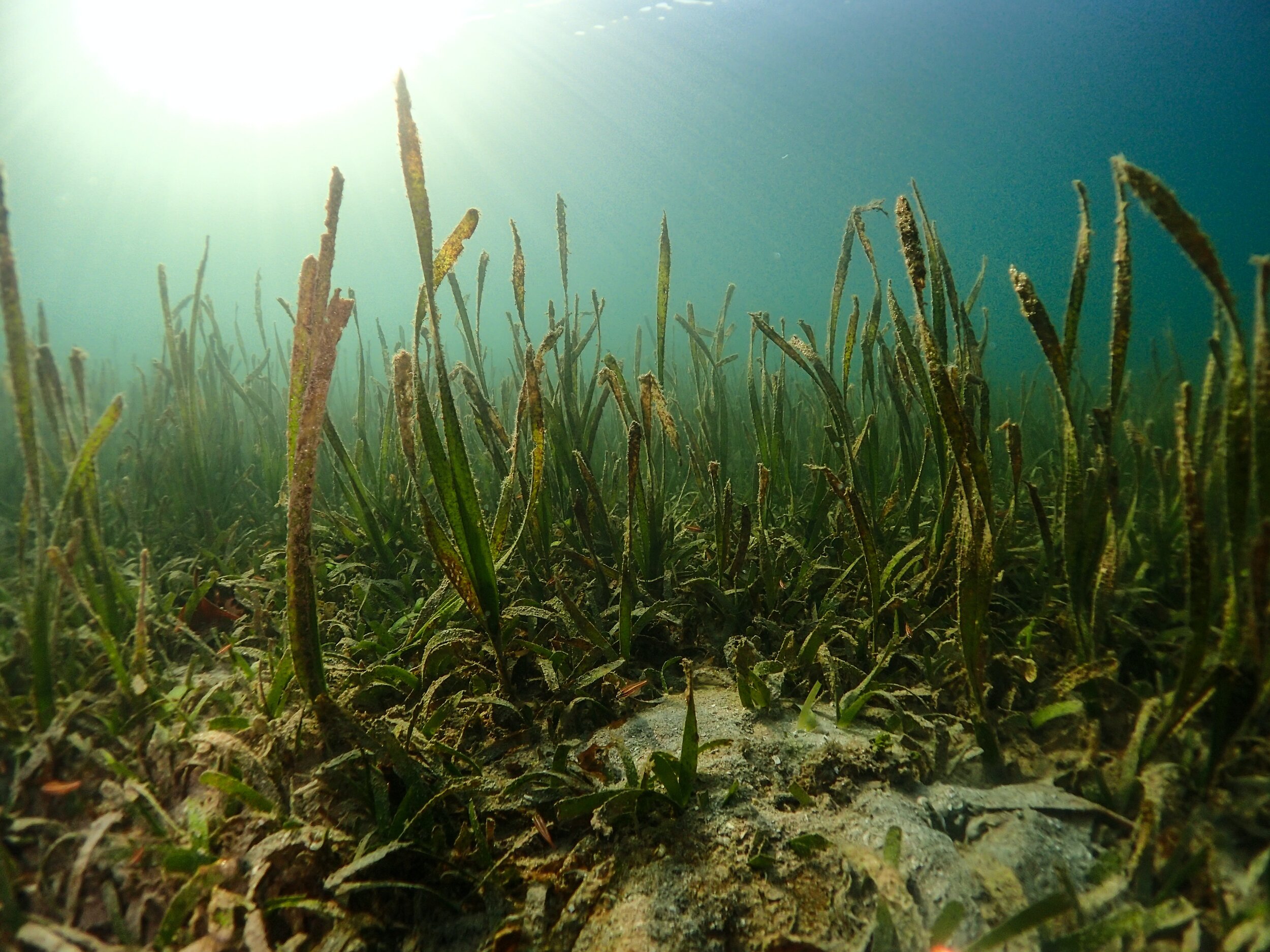Seagrass Meadows: A hidden tool for human and marine health?
Caitlin Thomas
Caitlin is an aspiring ecologist with a passion for marine ecology and accessibility in science. She is currently interning as an ecological consultant but will return to the University in Sheffield this September to complete her Ecology and Conservation Biology degree. In her free time, she writes environmental articles and creates illustrations for several charities and e-magazines.
Find her on Instagram (@caitlin.ecology) or Twitter (CaitlinAThomas2).
An Introduction to Seagrass
Did you know that on coastlines around the world you can find underwater meadows that are carbon sinks, biodiversity hotspots, and the source of our fishing stocks? These are seagrass meadows!
Commonly confused for seaweed, seagrasses are a type of flowering saltwater plant commonly found in shallow sheltered areas along the coast, such as estuaries and lagoons [1]. They anchor their roots into the sand, forming dense meadows which blanket the sea [1].
But why is seagrass important?
You’re probably wondering – why should I care about seagrass?
“Seagrass helps us tackle climate change by being one of the planet’s largest carbon sinks. Despite only occupying 0.1% of the ocean floor, it is responsible for 15% of the oceans total carbon absorption [2, 1]. One hectare of seagrass can even absorb 35 times more carbon dioxide than a hectare of Amazonian rainforest, and it is often referred to as ‘the lungs of the sea’ [3]!”
They’re biodiversity hotspots too.! Hundreds of different fish and invertebrate species can be found in seagrass – a study in the UK recorded over 50 species of fish in just one meadow [4]. In more tropical climates, seagrass is an important feeding ground for coral reef fish, green turtles and manatees [5].
Seagrass also supports 20% of the world's fisheries [6].! It does this by providing valuable nursery and shelter habitat for species important to fisheries, such as the Alaskan Pollock, which allows their populations to thrive [7]. Fish is an important source of protein relied on by millions around the world and many coastal communities rely on seagrass to support their livelihoods [8].
They also help engineer their local underwater environment! Their dense roots stabilise the seabed, giving a solid area for mangroves to grow [1].
What else can they do?
Carbon storage, nursery habitats and ecosystem engineering is not all – evidence suggests seagrass may play an important role in the health of humans and other organism’s.
Sewage pollution is a plague on our oceans, and causes disease that impacts us and other marine life. Therefore methods of water-filtration have been explored to tackle this issue, especially in the realm of nature-based solutions.
There is repeated evidence of use of natural water filtration systems globally: mangrove forests, restored bivalve reefs and even re-constructed wetlands [9]. There has even been evidence of phyto-chemicals isolated from seagrass tissues being able to inhibit pathogens when in a laboratory setting [9]!
These successes spurred Joleah Lamb, a postdoctoral researcher at Cornell University, and his team to investigate the potential of whole seagrass meadows as a system for water filtration and disease mitigation [9].
In waters off four Indonesian islands that lack basic wastewater filtration systems, the team assessed the impacts of seagrass on marine microbial pathogens and disease [9]. They used tests to measure levels of Enterococcus, a fecal bacteria causing infections, to determine if bacterial levels were influenced by seagrass presence [9, 10]. These tests are used by the USA’s environment authority to determine if bacterial levels are at safe levels around their beaches [11, 9].
In the USA, 120 is the safe limit – these studies recorded levels of over 2000 in areas with no seagrass meadows [9]. However, in areas of abundant seagrass – levels of Enterococcus were reduced three-fold [9]!
To investigate if this finding is applicable to diseases harmful to marine organisms, these researchers used the close relationship between reef-building corals and seagrass [9]. A study of over 8000 reef-building corals found that those next to seagrass meadows had a twofold reduction in disease levels compared to corals not next to these meadows [9]!
These results provide promising evidence that seagrass meadows can significantly reduce the levels of bacteria, a service that can positively impact both humans and marine organisms [9]!
The exact mechanisms that drive this reduction in pathogens by seagrass requires further research, but promising hypotheses involve their sediment-retention qualities or their ability to release large amounts of oxygen [9, 12].
These potential mechanisms and applications of seagrass may have been overlooked in the past due to the environments where the data has to be collected – nobody wants to spend time in sewage-polluted water [12]!
Applications for the future
The water filtration and disease battling qualities of seagrass may be applicable to the issues faced in the aquaculture industry.
Aquaculture is the farming of aquatic animals and plants, and it currently produces approximately half of the seafood consumed by humans globally [13]. Marine aquaculture production usually consists of species such as oysters, shrimp and salmon [13]. This industry faces issues from poor water quality, which leads to sub-optimal growth, disease, and ultimately death [14]. This reduces fish production from these farms, and ultimately reduces profits [14].
The solutions to maintain water quality at optimum and treat disease outbreaks are often costly, which again have economic implications for the industry [14]. To overcome this, nature-based solutions like seagrass offer a promising alternative.
To tap into the disease mitigation potential of seagrass, the University of Algarve and the Portuguese Institute for the Sea and Atmosphere investigated if seagrass could contribute to overcoming water-quality issues in naturally water-fed aquaculture pond [14]. Therefore, helping to boost productivity and profits [14]. They found that seagrass improved the inflowing water quality by retaining particulate matter on their leaves, as well as naturally oxygenating the reservoirs the fish are in so its above optimum levels [14].
“Fish farm” - Artur Rydzewski is licensed under CC by 2.0
Therefore, this study is a great example of how we can integrate seagrass into our lives to as a nature-based solution and to support the economy [14]!
This nature-based solution may also be applicable to wastewater issues in remote communities. Introducing and building wastewater infrastructure is often not possible in these areas due to expense and remoteness, however the water-filtration qualities of seagrass give it potential as a nature-based wastewater system [12]. Seagrass has the potential to be integrated into our lives and make them better!
Suffering seagrass
Yet, for an important ecosystem that offers a multitude of benefits to humans and marine organisms, it is suffering. Seagrass is an extremely threatened marine habitat, with 7% being lost each year since 1990 [10]. This equates to about 1 hectare being lost every hour [6].
Seagrass decline is caused by a range of human-induced threats, such as destructive fishing methods, pollution, and ocean warming [6]. A wasting disease in the 1930’s also killed 90% of one type of seagrass on the coasts of North America and Europe, and recovery has been hampered by human activities [15].
Despite this severe decline, there is hope for our underwater meadows and their ecosystem services – in the form of seagrass restoration projects taking place around the world!
One large scale restoration project is just off the coast of Virgina, USA. The Virginia Institute of Marine Science, partnered with The Nature Conservancy, planted 70 million seeds in a 200 hectare plot of previously barren coast [16]. This has led to natural propagation in the area, creating more than 3000 hectares of seagrass meadows – which is the world's largest restoration project to date! [16]
The Future
Seagrass meadows are one of the most valuable ecosystems present today, yet they are increasingly neglected and undervalued.
However, we are learning more everyday about how essential they are for the health of humans, marine organisms, and the ocean itself. Continued research and restoration, coupled with effective management will allow our meadows to thrive. We may even be able to utilise them to support our industries!
There is always more to learn about our meadows and how to protect them, but for now, things are looking up!
References
[2] https://www.frontiersin.org/articles/10.3389/fpls.2021.629962/full
[3] https://www.projectseagrass.org/influence/one-hectare/
[4] https://seagrass.org.uk/?page_id=183
[5] https://www.projectseagrass.org/why-seagrass/wildlife/
[7] https://conbio.onlinelibrary.wiley.com/doi/full/10.1111/conl.12566
[8] https://www.projectseagrass.org/why-seagrass/fisheries/
[10] https://www.aaas.org/news/seagrass-reduces-marine-pollution-and-disease
[11] https://www.ncbi.nlm.nih.gov/pmc/articles/PMC3510518/
[12] https://oursharedseas.com/blue-solutions/
[16] https://news.virginia.edu/content/some-good-news-seagrass-restored-eastern-shore-bays-flourishing



